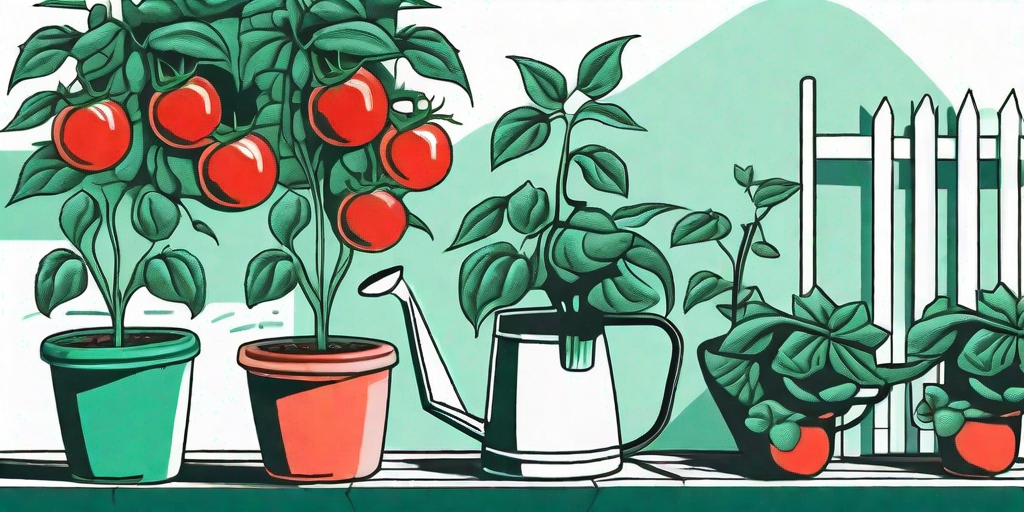
Ah, tomatoes. The ruby-red jewels of the garden, the tangy-sweet delight of salads, the heart and soul of a good pasta sauce. If you're reading this, chances are you've decided to embark on the noble quest of growing your own tomatoes. Congratulations, brave gardener! You're about to discover the joys (and challenges) of nurturing these sun-loving plants to their full, juicy potential. But fear not, for this guide is here to help you navigate the sometimes tricky waters of tomato cultivation.
The Basics of Tomato Watering
Before we dive into the nitty-gritty, let's get some basics out of the way. Tomatoes, like all plants, need water to survive. But not just any water, and not in any quantity. No, tomatoes are a bit like Goldilocks – they need their water just right. Too much, and they'll drown. Too little, and they'll shrivel up faster than a vampire in the sun.
So, how much is just right? Well, it depends on a few factors, such as the variety of tomato, the stage of growth, and the weather. But as a general rule of thumb, tomatoes need about 1-1.5 inches of water per week. This can come from rainfall, or from your trusty watering can or hose.
When to Water
Timing is everything when it comes to watering tomatoes. They prefer to be watered in the early morning, when the air is still cool and the sun isn't yet at its peak. This allows the water to soak into the soil and reach the roots before it can evaporate.
Watering in the evening can also work, but be careful – if the leaves get wet and stay wet overnight, it can create a perfect breeding ground for fungal diseases. So aim for the morning, and try to water the base of the plant, not the leaves.
How to Water
When watering tomatoes, aim for a slow, deep soak. This encourages the roots to grow deep into the soil, which helps the plant stay stable and access water and nutrients even during dry spells.
A good way to achieve this is by using a soaker hose or a drip irrigation system. These deliver water directly to the base of the plant, reducing evaporation and making sure the water goes where it's needed most. If you're using a watering can or a hose, aim for the base of the plant and water slowly, giving the soil time to absorb the water.
Advanced Tomato Watering Techniques
Now that we've covered the basics, let's move on to some advanced techniques for the truly dedicated tomato gardener. These methods require a bit more effort, but they can make a big difference in the health and productivity of your tomato plants.
Mulching
Mulching is a fantastic way to conserve water, suppress weeds, and improve the health of your soil. By covering the soil around your tomato plants with a layer of organic material (like straw, leaves, or compost), you can help keep the soil moist and cool, reduce evaporation, and add nutrients to the soil as the mulch breaks down.
Just be sure to leave a bit of space around the base of the plant – you don't want the mulch to touch the stem, as this can lead to rot.
Watering Schedules
While it's important to keep your tomato plants consistently watered, it's also a good idea to adjust your watering schedule based on the weather and the stage of growth. For example, during hot, dry periods, you may need to water more frequently. During cooler, wetter periods, you can probably cut back.
Similarly, tomato plants need more water during their fruiting stage than during their initial growth stage. So keep an eye on your plants and adjust your watering as needed.
Frequently Asked Questions
Why are my tomato plants wilting?
Wilting can be a sign of both under-watering and over-watering. If the leaves are wilted and the soil is dry, the plant is likely thirsty. If the leaves are wilted and the soil is wet, the plant may be waterlogged. Check the soil before watering to make sure it's in the Goldilocks zone – not too dry, not too wet, but just right.
What if it rains a lot?
If you're in a rainy area, you may not need to water your tomatoes at all. But be careful – too much rain can lead to waterlogged soil and root rot. If your tomatoes are in a pot, make sure it has good drainage. If they're in the ground, consider building a simple rain shelter to protect them from heavy downpours.
Final Thoughts
Watering tomatoes can be a bit of a balancing act, but with a bit of practice and attention, you'll soon get the hang of it. Remember, the key is to keep the soil consistently moist, but not waterlogged. Aim for a slow, deep soak in the early morning, and adjust your watering based on the weather and the stage of growth.
And most importantly, enjoy the process! There's something deeply satisfying about nurturing a plant from seed to fruit, and there's nothing quite like the taste of a homegrown tomato. Happy gardening!











